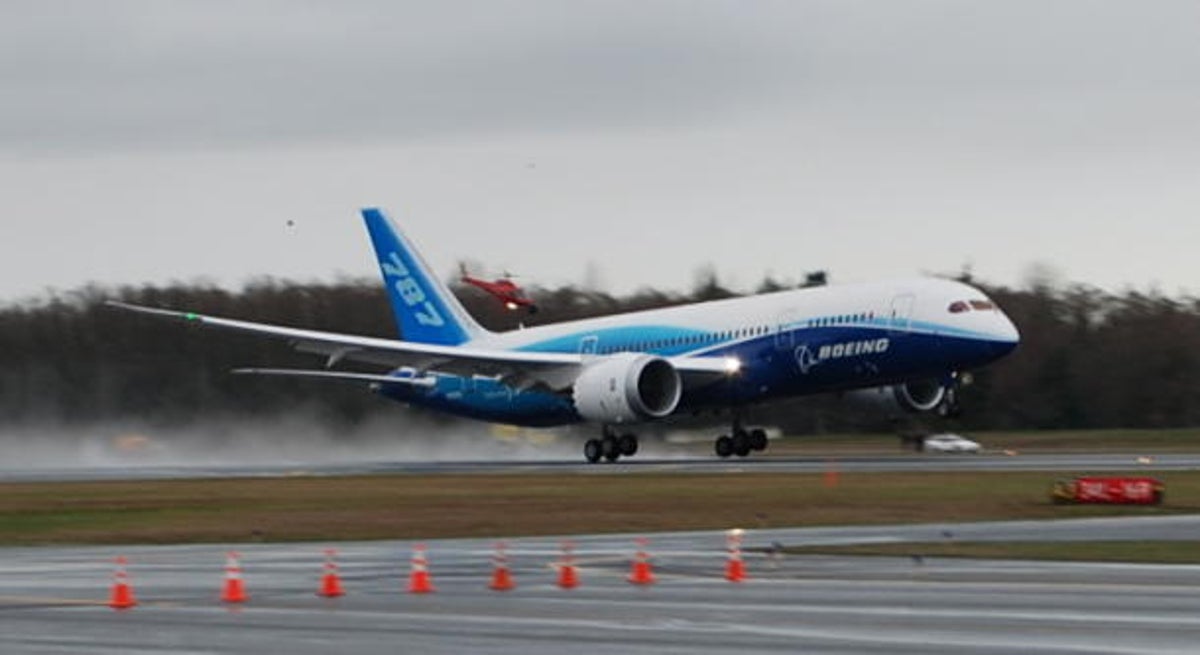Boeing's 787 faces sky full of competition (photos)
The 787 Dreamliner may be one of the most efficient jets in commercial history, but there's plenty of other planes in the sky.

787 Dreamliner taking off
But the 787, of course, is hardly the only commercial airplane plying the skies of the world. On this page and those that follow, CNET presents the airplanes from the 787's own parent, Boeing, and its archrival, Airbus, that compete with the 787 for passengers' dollars.
Seen here, the 787 makes its first-ever flight, from Payne Field in Everett, Wash., on December 15, 2009.
787 Range chart
The 787-8 will have a range of between 7,650 and 8,200 nautical miles and will typically carry 242 passengers in a three-class configuration. It is 186 feet long, its tail is 56 feet high, and its wingspan is 197 feet.
The 787-9 will have a range of between 8,000 and 8,500 nautical miles and can carry up to 290 passengers in a three-class configuration. It is 206 feet long, has a 56-foot-high tail, and a wingspan of 197 feet.
The 787 is said to be one of the most fuel-efficient airplanes in history thanks to its use of composite materials and advanced propulsion systems, as well as other advances. It is said to offer fuel savings of as much as 20 percent per passenger mile as other aircraft.
To date, Boeing has received 847 orders for the 787 Dreamliner.
Boeing 747-8 Intercontinental
The 747-8 has a range of 8,000 nautical miles and can carry 467 passengers in a three-class configuration. It is 250 feet long, has a 63-foot, 6-inch high tail, and a wingspan of 224 feet, 7 inches. The plane will feature four GEnx-2B67 engines and can carry up to 64,055 gallons of fuel.
Throughout the history of the 747 program, Boeing has received orders for 1,525 of the iconic airplanes.
Boeing 747-400ER
Airbus A380
The A380 operates on four GP 7200 or four Rolls-Royce Trent 900 engines. Recently, a Qantas A380 experienced the in-flight failure of one of the Rolls-Royce engines. The plane was able to land safely, and the fleet has not been grounded.
To date, Airbus has taken orders for 234 A380s, and 41 are in service. The plane can hold 84,600 gallons of fuel and is seen as one of the most efficient airliners in history when measured by the cost per passenger mile.
Boeing 777-200 LR Worldliner
All told, Boeing has received orders for 1,163 777s of all models.
Airbus A340-500
The plane is 223 feet long, has a 57-foot-high tail, and a wingspan of 208 feet.
Airbus A340-600
This plane also features four Rolls-Royce Trent 500 engines and can hold 51,570 gallons of fuel. It is 247 feet long, can hold up to 380 people in a three-class configuration, and has a 56-foot, 6-inch tail. Its wingspan is 208 feet.
Airbus A350-XWB
The A350 series is thought to offer 25 percent cost savings over its closest long-haul competitor, thanks to, among other things, composite structures combined with titanium and aluminum alloys.
The plane will come in three configurations, the A350-800, -900, and -1000. It will offer ranges from 8,000 to 8,500 nautical miles, and carry between 270 and 375 passengers in 3-class configuration. Each model will feature two Rolls-Royce Trent XWB engines. The planes' lengths vary from 199 feet to 242 feet, and each has a 56-foot-high tail, and a wingspan of 212 feet. The planes will carry as much as 41,211 gallons of fuel.
Airbus A350-XWB cutaway
Airbus A340-300
It is 209 feet long, has a 55-foot, 6-inch high tail, and a wingspan of 198 feet. It features four CFM56-5C4/P engines and can carry up to 37,150 gallons of fuel.
Airbus A330-200
It is 193 feet long, has a 57-foot-high tail, and wingspan of 198 feet. It uses two PW 4000 or two GE CF6-80E1 or two RR Trent 700 engines. Its fuel capacity is 36,750 gallons.
Boeing 767-400
The plane is 201 feet long, has a 55-foot-high tail, and a wingspan of 170 feet.
Boeing has taken orders for 1,044 planes across the entire 767 line.
Airbus A330-300
Airbus has taken orders for 482 of the planes, of which 340 are currently in operation. It features two PW 4000 engines, and a capacity of 25,765 gallons of fuel.
The plane is 209 feet long, has a 55-foot-high tail, and a wingspan of 198 feet.

